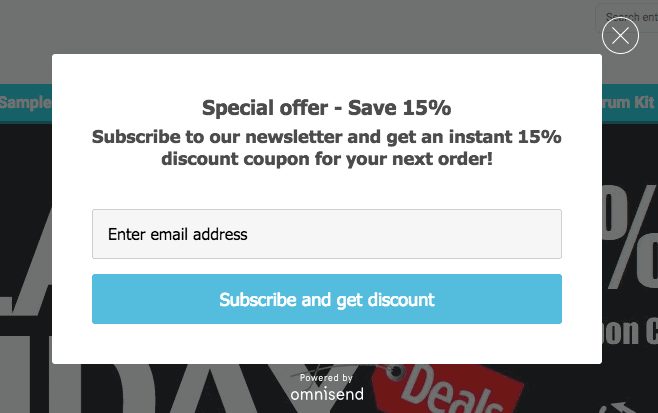Are you wondering if you should be using popups in e-commerce?
Most marketing “gurus”, including the folks over at Shopify, recommend using popups.
I disagree.
I’ve used popups extensively in all sorts of different businesses setups. And after almost a decade of using them, I can conclude that popups aren’t always a good idea.
I’ll explain why in a second.
But first we need to talk about the different types of popups that exist.
Different Types of Popups: The Good, the Bad and the Ugly In a Nutshell
1) Timed Popups in E-Commerce
Until recently, the most common form of popups were timed popups.
These are popups that open after a visitor has spent a certain amount of time on a web page.
For example:
You could set the popup to open after 10 seconds.
This way visitors have some time to engage with your website before the popup interrupts them. The problem with these timed popups is that interrupting someone during an active behavior is rarely a good idea. If someone is reading a product description, the last thing they want is to get interrupted. In fact, you may even end up getting considerably less conversions.

Whenever I read a blog post and a timed popup interrupts me, I immediately close it. To be honest, I don’t even look at what the popup is about. It’s annoying, intrusive and rude.
Imagine you’re standing at the bus station, deeply immersed in reading the newspaper.
Out of nowhere, without announcement, a stranger walks up to you and interrupts you.
Would you consider this rude?
I certainly would.
And timed popups are a bit like that, just online.
I don’t recommend using timed popups in e-commerce because they interrupt the user flow.
2) Exit Popups in E-Commerce
Exit popups are way more interesting.
These popups use a technology called exit intent.
They only open when a user has finished browsing your website and attempts to exit your website. As soon as the software detects the mouse cursor moving outside of the browser window, the popup is triggered. This is less rude and not nearly as intrusive.
Of course, any form of popup interrupts the user flow. But getting interrupted while you’re deeply immersed in reading a blog post or learning about a product is a lot more annoying than getting interrupted while you’re about to exit the website.
Let me give you an example.
Whenever I shop in a store I get annoyed if a pushy sales person approaches me.
I just want to check out the products and be left alone. I prefer taking the first step and approaching a sales person or store clerk if I need some assistance or have a question. But getting interrupted out of the blue, while I’m immersed in an activity, is the worst.
Now imagine someone hands me a flyer as I’m walking out of the store.
That’s way less intrusive.
My attention is not bound up in an ongoing activity.
In fact, as I’m walking out of the store, my attentional resources are freed up. Because of this, I’m much more likely to pay attention to an offer or advertisement. Since I’m on my way out of the store, I wouldn’t consider it rude either. It’s more like a friendly “goodbye” than a disrespectful interruption. The data confirms this by the way.
Exit popups or exit full-page overlays tend to have higher conversion rates.
3) Entry Popups in E-Commerce
Entry popups are triggered immediately when someone visits your website.
These can be quite annoying.
First of all, you’re bombarded with too much information. You clicked on a link to check out something and you’re immediately interrupted. It’s likely that you’ll close the popup because you first want to check out what the site is all about in the first place.
Entry popups are a bit like walking into a store and getting approached by a sales person right away. The moment you set your foot into the door, someone starts talking to you.
I’m not sure about you, but in my case, I find this annoying.
And things aren’t different online.
Why Using Popups In E-Commerce Will Likely Lower Your Conversion Rate In 99% of Cases
As you can see, there are different types of popups.
But they all have one thing in common:
They are annoying.
Of all popups, exit popups can be considered the least annoying and intrusive. They tend to work best because you interrupt a visitor during a key moment where their attentional resources are freed up. So why do I recommend you don’t use popups in e-commerce?
There’s two main reasons:
- Most ad platforms don’t allow exit and entry popups
- Popups can distract from the main goal of your landing page
Let’s start with the first reason.
Facebook’s ad policy used to state that popups that open when a user enters or exits a website are not allowed. These days they have rephrased the prohibited practice to the “use [of] popup ads, interstitial ads or other ad formats that disrupt the user experience on your landing page”
They don’t explicitly state that exit and entry popups aren’t allowed.
(They used to.)
But if you’re planning to hold on to your Facebook ad account I recommend you don’t use any kind of popup, welcome gate, slide-in or full-page overlay that disrupts the user experience.
I’ve seen ad accounts getting banned because of this.
You might get away with it, but if your traffic heavily depends on Facebook ads, it’s better to play it safe. I’d particularly stay away from entry popups and exit popups (this includes anything that interrupts the user flow including welcome gates, full-page overlays and full-page slide-ins).
The second reason is more important though.
If someone clicks on your Facebook ad and visits your product page, you want them to complete a certain action. In most cases you want them to buy the product you’re advertising.
Using popups in e-commerce divides this intent.
If you want your visitors to buy a product, and that’s the main goal of your advertising, then you should get rid of anything that distracts from this action or interrupts the user flow.
Here’s the thing:
Popups can distract a user from making a purchase.
A customer might be in the process of buying a product and get interrupted by a popup.
This can go wrong multiple ways:
- The customer gets confused or overwhelmed with options
- The customer is technically unable to close the popup for whatever reason
- The customer enters her email address to receive a discount code (but the email ends up in the spam folder or she gets lost browsing her emails and never returns)
Most people have never thought of the possibility that popups may lower conversion rates.
But in my experience that’s exactly what happens.
Distractions are one of the biggest conversion killers in e-commerce.
And in most cases popups are just that. Rather than helping you make a sale, they distract users by interrupting the user flow. And this results in less people completing the purchase.
So my advice is:
Keep your landing pages clean.
Focus on one action only and remove all distractions.
There’s a time and place to collect email addresses, but you shouldn’t do it while you’re also trying to make a sale at the same time. It’s better to create dedicated lead generation campaigns that focus on building your email list. You know how the saying goes:
“If you chase two rabbits you will catch none”.
So should you never use popups in e-commerce or are there exceptions?
When It’s Okay to Use Popups in E-Commerce
Like with everything there are exceptions to the rule.
Popups are great in some situations.
For example, when you’re running an influencer marketing campaign, you don’t have to worry about breaching Facebook’s ad policy. You can freely use exit popups to collect the email addresses of abandoning visitors or add more incentives for someone to complete the checkout process. If you’re going to use popups at all, I recommend using exit popups.
This way you aren’t distracting customers or interrupting your website’s user flow.
Another scenario is if your site’s traffic mainly comes from organic Google searches or referrals (such as affiliates who are sending you traffic), I recommend using exit-intent popups to collect emails. Just stay away from popups when using advertising platforms.




